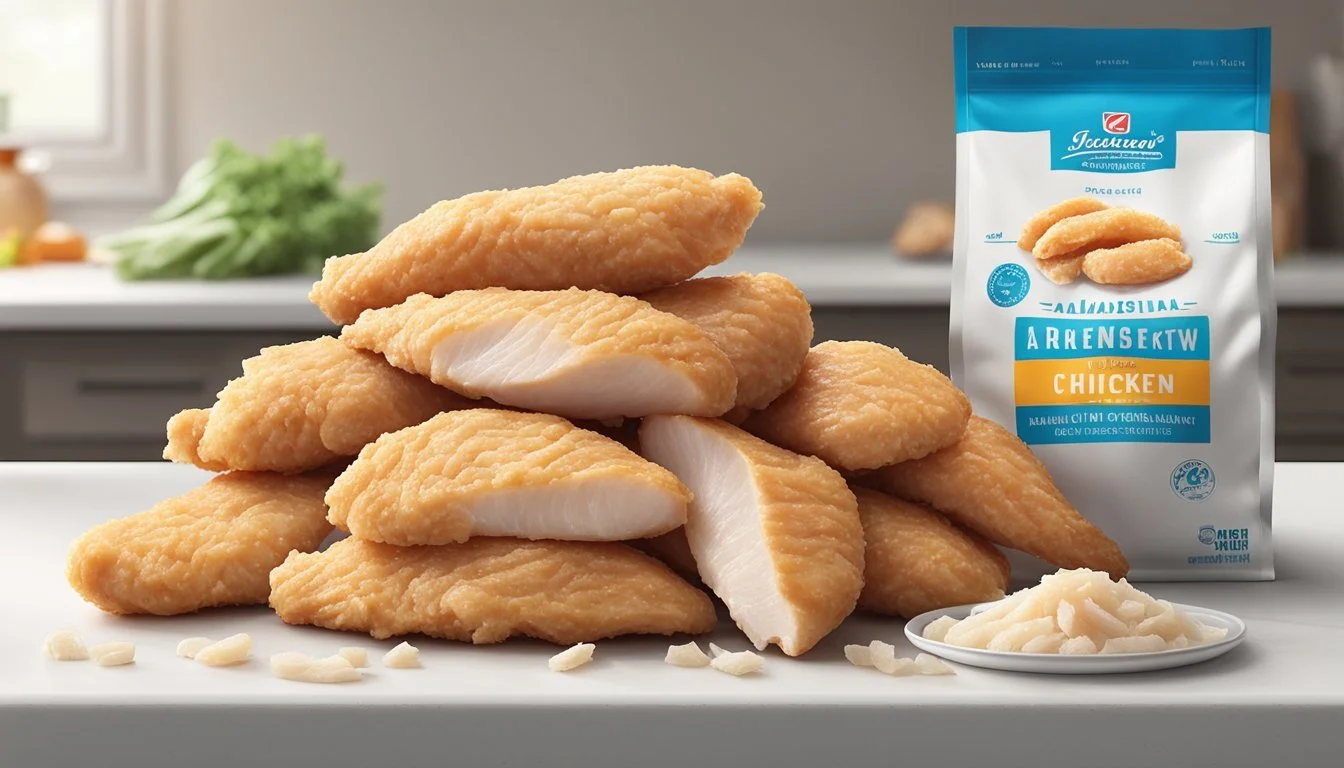Fresh vs. Frozen Chicken: Unraveling the Myths and Facts for Better Meals
Chicken is a versatile and popular protein choice for many households. When it comes to buying chicken, consumers often face a decision between fresh and frozen options. Both have their merits, but understanding the differences can help make an informed choice.
Fresh and frozen chicken are nutritionally equivalent, with no significant differences in protein content, vitamins, or minerals. The main distinctions lie in convenience, shelf life, and potential texture variations. Fresh chicken offers immediate use and a desirable texture, while frozen chicken provides longer storage and can be more cost-effective.
Food safety is a crucial consideration for both types. Fresh chicken requires prompt refrigeration and use within a few days, while frozen chicken can be stored for months. Proper handling and cooking techniques are essential for both to ensure safe consumption. Ultimately, the choice between fresh and frozen chicken often comes down to personal preference, cooking needs, and storage capabilities.
Understanding Chicken
Chicken is a versatile and popular protein source available in both fresh and frozen forms. Each type offers unique characteristics that influence quality, taste, and nutritional value.
Fresh Chicken Explained
Fresh chicken is typically sold shortly after slaughter, maintaining its peak freshness. It has a shorter shelf life, usually 1-2 days in the refrigerator. Fresh chicken is often considered juicier and more tender than its frozen counterpart.
The meat's texture is naturally soft, making it ideal for various cooking methods. Fresh chicken retains its original flavor profile, which many consider superior. However, it requires prompt use to avoid spoilage.
Purchasing fresh chicken allows for immediate inspection of quality. Look for firm, pinkish meat without discoloration or strong odors.
Frozen Chicken Fundamentals
Frozen chicken offers convenience and extended storage. It's typically flash-frozen shortly after processing, preserving its nutritional value. Proper freezing prevents the formation of large ice crystals, which can damage cell structures.
When stored at 0°F (-18°C), frozen chicken can last up to 9 months without significant quality loss. It's often more affordable and available year-round. Frozen chicken is packed professionally, reducing the risk of contamination.
Thawing methods impact the final product's quality. Slow thawing in the refrigerator is recommended to maintain texture and moisture content.
Nutritional Profile Comparison
Both fresh and frozen chicken provide similar nutritional benefits. They are excellent sources of protein, essential vitamins, and minerals. Protein content remains stable during freezing, with no significant loss.
Frozen chicken may experience minimal nutrient loss due to the freezing process, but it's generally negligible. Both types offer comparable amounts of B vitamins, particularly niacin and vitamin B6.
Fresh chicken might have a slight edge in retaining certain water-soluble vitamins. However, the difference is often minimal and doesn't significantly impact overall nutritional value.
Fat content and calorie count remain consistent between fresh and frozen options. Both are lean protein sources when choosing skinless cuts.
Health and Nutritional Aspects
Fresh and frozen chicken both offer valuable nutritional benefits as lean protein sources. Their nutrient profiles are quite similar, with only minor differences in certain vitamins and minerals.
Macro and Micronutrient Content
Chicken is an excellent source of protein, providing essential amino acids for muscle growth and repair. Both fresh and frozen varieties contain approximately 31 grams of protein per 100 grams of meat.
Fat content is low, typically around 3.6 grams per 100 grams. Chicken also provides important micronutrients:
Iron: crucial for oxygen transport
Selenium: supports immune function
Phosphorus: essential for bone health
Niacin: aids in energy metabolism
Vitamin content may vary slightly between fresh and frozen chicken. Some water-soluble vitamins, like B vitamins, can be lost during the freezing process. However, this loss is minimal and does not significantly impact overall nutritional value.
Preservatives and Additives
Fresh chicken generally contains no additives. Some frozen chicken products may include preservatives or sodium-based solutions to maintain moisture and extend shelf life.
Saline solutions are sometimes added to frozen chicken, which can increase sodium content. Consumers should check labels for added ingredients.
Frozen chicken without additives offers nutritional content nearly identical to fresh. Processed frozen chicken products may contain higher levels of sodium and preservatives.
Cholesterol levels remain consistent between fresh and frozen chicken, averaging around 85 milligrams per 100 grams of meat.
Culinary and Preparation Insights
Fresh and frozen chicken offer distinct culinary experiences, influencing cooking methods and final dish outcomes. The choice between them impacts texture, flavor, and preparation techniques.
Texture and Flavor Profiles
Fresh chicken breasts typically provide a tender and juicy texture when cooked properly. They retain more natural moisture, resulting in a succulent eating experience. The flavor of fresh chicken is often described as pure and clean.
Frozen chicken breasts can be slightly drier due to ice crystal formation during freezing. This process may cause some moisture loss. However, proper thawing and cooking techniques can mitigate this effect. Frozen chicken's flavor remains largely intact, though some subtle nuances may be less pronounced.
Both options are versatile for various recipes. Fresh chicken excels in dishes where moisture retention is crucial, like grilled or pan-seared preparations. Frozen chicken works well in stews, soups, and casseroles where additional liquid is present.
Cooking Techniques and Times
Fresh chicken requires minimal preparation and can be cooked immediately. It's ideal for quick meals and last-minute recipe decisions. Cooking times for fresh chicken are generally shorter due to its higher moisture content.
Frozen chicken needs thawing before cooking. Safe defrosting methods include:
Refrigerator thawing (24 hours for boneless breasts)
Cold water thawing (1-2 hours, changing water every 30 minutes)
Microwave thawing (follow manufacturer instructions)
Cooking times for thawed, previously frozen chicken are similar to fresh. However, cooking directly from frozen is possible, though it typically requires 50% longer cooking time. This method works best for soups, stews, and slow-cooker recipes.
Both fresh and frozen chicken should reach an internal temperature of 165°F (74°C) for safe consumption. Using a meat thermometer ensures proper doneness without overcooking.
Practical Considerations
Fresh and frozen chicken each come with distinct advantages and challenges in terms of storage, cost, and convenience. These factors can significantly impact purchasing decisions and meal planning strategies.
Storage and Shelf Life
Fresh chicken requires prompt refrigeration and typically lasts 1-2 days in the refrigerator. Proper storage is crucial to maintain quality and prevent bacterial growth. Freezing fresh chicken extends its shelf life to 9-12 months when stored at 0°F (-18°C) or below.
Frozen chicken offers extended storage life, lasting up to 12 months in a home freezer. This long shelf life reduces food waste and allows for bulk purchasing. However, frozen chicken must be thawed safely to prevent foodborne illnesses. Thawing methods include refrigerator thawing (24 hours per 4-5 pounds) or cold water thawing (30 minutes per pound).
Expense and Affordability
Fresh chicken is often more expensive due to shorter shelf life and higher transportation costs. Prices fluctuate based on seasonal availability and market demand. However, sales and promotions can make fresh chicken more affordable.
Frozen chicken is generally more budget-friendly, especially when bought in bulk. Its longer shelf life allows retailers to offer consistent pricing. Cost savings can be significant for families or individuals looking to stock up.
Type Average Price Per Pound Fresh $2.50 - $4.00 Frozen $1.50 - $3.00
Convenience and Lifestyle Factors
Fresh chicken offers immediate use without thawing, ideal for spontaneous meal preparation. It's versatile for various cooking methods and recipes. However, it requires frequent shopping trips and careful meal planning to avoid spoilage.
Frozen chicken provides convenience for busy lifestyles. It allows for stocking up and reduces grocery store visits. Individually frozen pieces offer portion control. Thawing time must be factored into meal planning, but some recipes allow cooking from frozen.
Pre-portioned frozen chicken breasts or strips can be particularly convenient for quick meals. They eliminate the need for cutting and reduce preparation time.
Societal and Environmental Impacts
The choice between fresh and frozen chicken has significant implications for sustainability and food waste. Consumer decisions can impact environmental outcomes related to packaging, transportation, and energy use.
Sustainable Choices and Impact
Frozen chicken offers advantages in reducing food waste. Consumers can use only what they need, avoiding spoilage of fresh meat. This aligns with efforts to decrease the 400 pounds of food waste per person annually in the United States.
Freezing allows chicken to be preserved at peak ripeness, potentially maintaining nutritional value better than fresh options transported long distances. However, frozen products typically require more packaging, which has environmental costs.
Transportation impacts vary. Fresh chicken may travel shorter distances but requires refrigerated transport. Frozen chicken can be shipped more efficiently in larger quantities.
Energy use differs between fresh and frozen. While freezing requires initial energy input, frozen chicken reduces energy needed for frequent shopping trips. Home storage of frozen chicken consumes ongoing freezer energy.
Ultimately, both options have trade-offs. Consumers can make sustainable choices by selecting local fresh chicken when available or opting for frozen to minimize waste.



